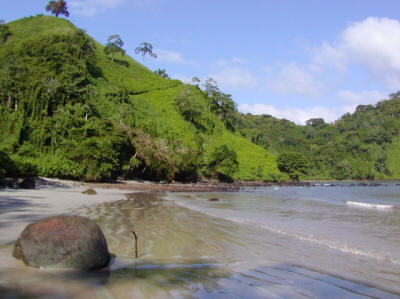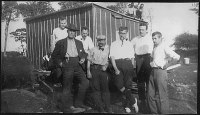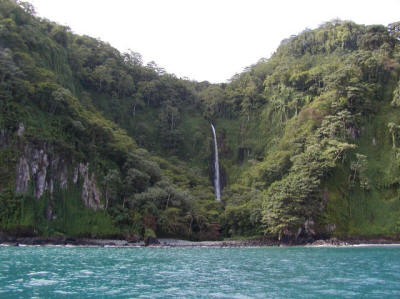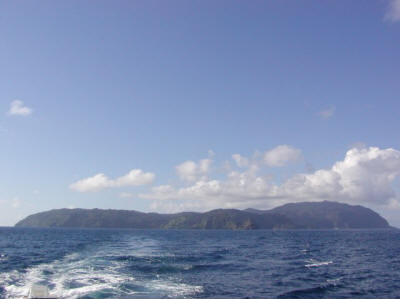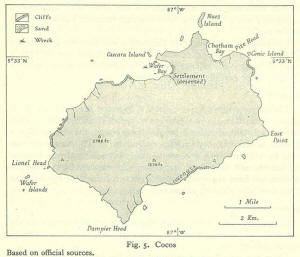The Treasure of Cocos Island
Above: Chatham Beach on Cocos Island. Photo by J RAWLS.
350 miles west of Costa Rica lies the tiny and uninhabited Cocos Island.
It is believed that a vast treasure was hidden here in 1821 by the mutinous crew of the Mary Dear (or Mary Deare, depending on source), a British ship chartered to move gold, silver and jewels from the churches of Lima, Peru to the safety of Spain.
Shortly after leaving the port of Callao, the gold hungry crew of the Mary Dear murdered the six soldiers charged with guarding the treasure, seized control of ship and sailed to Cocos Island where, it is said, they hid the treasure in a cave and then set sail for Panama.
Above: President Franklin D. Roosevelt (aged 27) and friends on Cocos Island searching for the treasure in 1910. Image courtesy of the National Archives and Records Administration
Upon arriving in Panama the mutineers were arrested, most of the crew were executed, but three were spared after promising the Spanish authorities that they would assist in the recovery of the treasure.
Two of the three were taken to Cocos by a detachment of soldiers, soon after arriving, the two men escaped from their captors into the dense jungle. The soldiers, unable to locate the mutineers and believing that the two men would be unable to escape the island, returned to Panama.
Above: A waterfall on Cocos Island. Photo by J RAWLS.
A year later, the two men were picked up by a passing ship and taken to Costa Rica.
One of the two passed on the location of the treasure, in the form of a map, to a man named John Keating. Keating, with the help of the third mutineer, a man named Boag, later located the treasure on the island but the crew of the ship that had taken them to Cocos demanded a share, facing a mutiny, Keating and Boag hid in the jungle until the crew gave up searching for them and sailed away.
Above: Cocos Island, said to be the location of many hoards of pirate treasure. Photo by J RAWLS.
After an unknown period, Keating was picked up from the island by a passing ship and claimed that Boag had drowned, although he would later say that he had murdered him and left his body in the cave with the treasure.
Before his death in 1882, Keating passed the Cocos secret on to three people (why he did not go back for the bulk of the treasure himself is not clear), his wife, Fred Hackett and Nicholas Fitzgerald.
Keating's widow and Fred Hackett teamed up and headed to Cocos - they found nothing. The third man, Nicholas Fitzgerald, did not go in search of the treasure but passed the map Keating had given him to Admiral Henry Palliser - who also found nothing.
It has been claimed that frequent earthquakes on the island have destroyed vital landmarks necessary to accurately interpret the clues on the map.
Many have gone in search of the Cocos Treasure, even members of Jacques Cousteau's crew made a somewhat half hearted attempt at locating the treasure with a (now dated) underwater pulse induction metal detector during a visit to film the island and its reefs. [Cocos Islands: Sharks of Treasure Island, documentary film starring Jacques Cousteau and crew. From Cousteau's Rediscover The World series.]
Another notable to search for the treasure on Cocos was land and water speed record holder Sir Malcolm Campbell (father of Donald Campbell).
As far as we know, all who have searched for the treasure of Cocos Island have come back empty handed.
Further Reading
On Buried and Sunken Treasure by Rupert Furneaux, Penguin Books, 1973, Pb. 48pp. no index.
My Greatest Adventure; Searching for Pirate Treasure in Cocos Island by Malcolm Campbell, Butterworth 1931, 260 pp.
The Voyage of the Herman by Theon Wright
Documentary Films
Cocos Islands: Sharks of Treasure Island, documentary film starring Jacques Cousteau and crew. From Cousteau's Rediscover The World series. Can be found on disk 7 of The Ultimate Jacques Cousteau Collection, a must buy for any diver.

